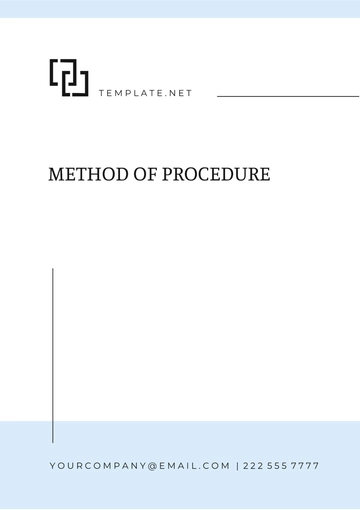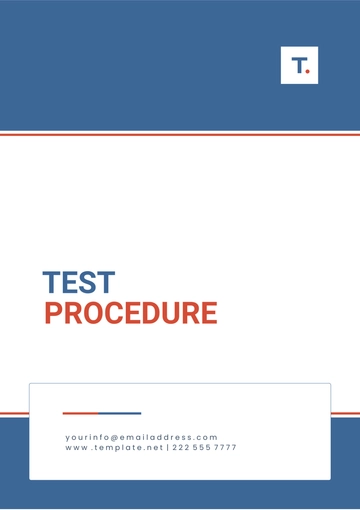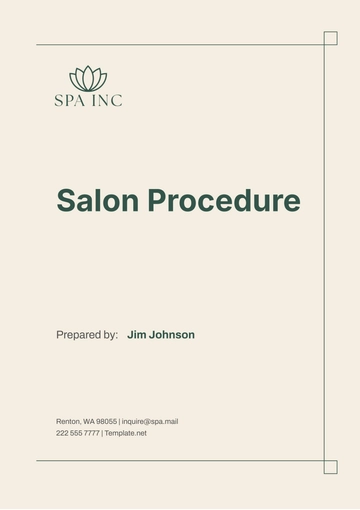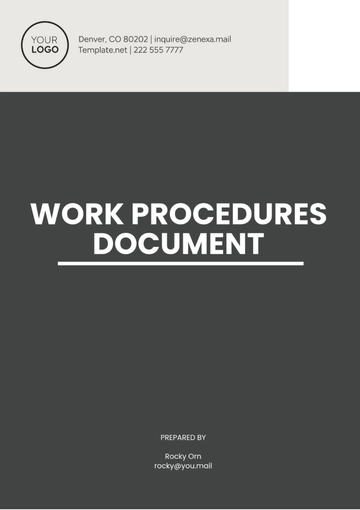Free Restaurant HR Procedure

I. Introduction
This document delineates the standardized Human Resources procedures for [YOUR COMPANY NAME], aimed at optimizing hiring, training, and performance management to ensure fairness, consistency, and compliance with applicable employment laws. This comprehensive guide supports our commitment to operational excellence and high standards in employee relations.
The primary objectives of this HR Procedure include:
Ensuring transparent and equitable recruitment processes.
Providing effective and ongoing training tailored to specific job roles.
Implementing a structured performance management system that aligns individual achievements with organizational goals.
II. Hiring Process
The hiring process at [YOUR COMPANY NAME] is meticulously designed to attract and select candidates who not only meet the technical requirements of the job but also align with our corporate culture and values. This multi-step process ensures we maintain a high standard of talent acquisition, which is critical for our continued success and growth.
A. Job Posting
Staffing Needs Assessment: In collaboration with department heads, we assess and forecast staffing needs considering seasonal fluctuations, business expansion, and operational objectives.
Job Description Development: We craft detailed job descriptions that outline specific duties, necessary skills, preferred qualifications, and performance expectations. This clarity helps ensure that applicants fully understand what will be expected of them.
Job Posting Strategy:
Internal Posting: Priority is given to internal candidates to encourage professional growth and retention within our company.
External Advertising: We leverage our company website, industry-specific job boards, and social media platforms to cast a wide net and attract diverse talent.
Application Timeline: A clear timeline for submitting applications is established, allowing adequate time for a wide range of candidates to respond.
B. Applicant Screening
Resume Collection: We implement a secure and organized system to collect and store resumes up to the application deadline.
Criteria-Based Screening: A scoring system is employed to evaluate applicants objectively based on the key qualifications and skills outlined in the job descriptions.
Initial Candidate Selection:
Selection Panel: A committee is formed to ensure a variety of perspectives in the screening process and to uphold the integrity and fairness of candidate selection.
Candidate Shortlisting: Candidates are shortlisted not only on the basis of their qualifications but also on their potential cultural fit and capacity for growth within the company.
C. Interviews and Selection
Interview Setup:
Initial Interviews: These are conducted either via video conferencing or in-person to assess general qualifications and interpersonal skills.
Second Interviews: Deeper, more focused discussions are held to delve into candidates’ specific skills, experiences, and alignment with our company values.
Final Selection:
Deliberation: The selection committee carefully reviews interview performances based on established benchmarks.
Offer Extension: Successful candidates receive job offers, which include detailed terms, compensation, benefits, and expected start dates.
III. Employee Onboarding
Onboarding at [YOUR COMPANY NAME] is a comprehensive process designed to integrate new hires into our operations and culture smoothly and effectively. This critical phase supports the transition of new team members, ensuring they are well-prepared to contribute to our success.
Employment Documentation: We prepare all necessary documents, including contracts, tax forms, and benefits information, along with a detailed employee handbook that outlines company policies.
Welcome Orientation:
Company Culture: New hires are introduced to our mission, core values, and the overarching ethos of the company.
Operational Knowledge: We provide essential information about daily operations, key contact points, and important company locations.
Mentorship Program:
Mentor Assignment: Each new employee is paired with an experienced mentor who provides guidance, answers questions, and helps facilitate a smooth transition.
Onboarding Feedback: We establish a feedback loop to continuously improve the onboarding process based on the experiences and insights of new hires.
IV. Training Programs
Continuous professional development is a cornerstone of our HR strategy. [YOUR COMPANY NAME] is committed to providing comprehensive training programs that enhance the skills and knowledge of our staff, ensuring high performance and compliance with industry standards.
Role-Specific Training:
We identify the critical skills and knowledge required for each position within the company.
Customized training modules are developed to target these specific needs, ensuring all team members are equipped to excel in their roles.
Training Material Development:
In collaboration with department heads and external experts, we ensure our training content is both comprehensive and up-to-date.
Training Schedule:
Training sessions are strategically scheduled to minimize disruption to our operations.
Regular training is mandated for both new hires and existing employees to maintain consistent service standards and compliance.
Training Evaluation:
We implement robust mechanisms to assess the effectiveness of our training programs through tests, practical assessments, and participant feedback surveys.
Table: Annual Training Overview
Department | Skill Focus | Sessions Per Year | Completion Rate |
|---|---|---|---|
Kitchen | Food Safety | 4 | 98% |
Front of House | Customer Service | 6 | 95% |
Administration | Compliance and Ethics | 2 | 99% |
This structured approach to hiring, onboarding, and training ensures that [YOUR COMPANY NAME] not only attracts and retains top talent but also supports their development and integration into our corporate culture, driving our continued success.
V. Performance Management
[YOUR COMPANY NAME] views performance management as a strategic approach to maintaining and enhancing individual and organizational effectiveness. Our comprehensive performance management system is designed to foster an environment of continuous improvement, align individual goals with company objectives, and promote personal growth.
Regular Performance Reviews: We conduct semi-annual reviews to evaluate employee performance against predefined objectives. These sessions provide a platform for open dialogue between managers and employees, fostering a mutual understanding of expectations and achievements.
Objective Setting: Each employee collaborates with their supervisor to set clear, measurable, attainable, relevant, and time-bound (SMART) goals that contribute directly to departmental and company success.
Constructive Feedback: Regular feedback is integral to our approach, offering both recognition of achievements and constructive suggestions for areas of improvement. Managers are trained to deliver feedback in a manner that motivates employees and fosters professional development.
Table: Performance Management Schedule
Activity | Frequency | Objective |
|---|---|---|
Performance Reviews | Semi-annually | Assess achievements and set new goals |
Feedback Sessions | Quarterly | Provide ongoing constructive feedback |
Goal Setting | Annually and as needed | Align individual goals with organizational needs |
VI. Compliance and Legal Requirements
Compliance with local, state, and federal employment laws is paramount at [YOUR COMPANY NAME]. Our HR department ensures that all company policies and practices not only meet but exceed legal requirements to protect both our employees and our business.
Regular Legal Updates: The HR team stays abreast of all changes in employment law through continuous education, legal subscriptions, and participation in relevant workshops and seminars.
Employee Handbook Updates: Our comprehensive employee handbook is reviewed and updated annually to reflect any changes in law or company policy. This ensures all team members have access to the latest information and guidelines.
Compliance Training for HR Staff: All HR personnel undergo annual training to refresh their knowledge of compliance issues, ensuring our practices remain on the cutting edge of legal and ethical standards.
Table: Compliance Training Overview
Training Topic | Frequency | Participants |
|---|---|---|
Employment Law | Annually | HR Team |
Data Protection | Biannually | HR Team, Managers |
Workplace Ethics | Annually | All Employees |
VII. Record Keeping
Effective record keeping is a cornerstone of professional HR management. At [YOUR COMPANY NAME], we maintain meticulous records for each employee to ensure confidentiality, accuracy, and compliance with applicable laws.
Types of Records Kept: We store personal information, employment contracts, performance reviews, and training records. All records are kept secure and confidential, accessible only to authorized personnel.
Digital Record System: Our digital HR management system ensures records are easily accessible while being securely stored. This system allows for efficient retrieval and updating of records, reducing the risk of errors and data breaches.
Retention and Disposal: We adhere to strict guidelines for record retention and disposal to comply with legal requirements and protect employee privacy.
Table: Record Retention Schedule
Document Type | Retention Period | Storage Method |
|---|---|---|
Employment Contracts | 7 years post-employment | Secure digital storage |
Performance Reviews | 5 years | Secure digital storage |
Training Records | Indefinitely | Secure digital storage |
VIII. Procedure Review and Update
Introduction: To ensure our HR procedures remain effective and relevant, [YOUR COMPANY NAME] conducts regular reviews and updates. This proactive approach allows us to adapt to evolving business needs, regulatory changes, and best practices in human resources management.
Annual Review: Each year, the HR team reviews all procedures to ensure they align with current business objectives and legal standards.
Procedure Updates: Any changes needed are documented meticulously, and updated procedures are approved by senior management before implementation.
Communication of Changes: All updates to HR procedures are communicated to employees through email, company meetings, or updates to the company intranet. This ensures everyone is informed and can adapt to changes in a timely manner.
Table: Procedure Update Log
Procedure | Last Updated | Changes Made |
|---|---|---|
Onboarding Process | January 2050 | Revised mentorship program |
Performance Management | June 2050 | Updated review frequency |
Compliance Training | March 2050 | Added data protection module |
Conclusion
These HR procedures are designed to ensure that [YOUR COMPANY NAME] operates efficiently and ethically, promoting a professional and organized work environment. Adherence to these guidelines will support our ongoing commitment to employee development and organizational success. For further details or specific concerns, please contact the HR department at [YOUR COMPANY EMAIL].
- 100% Customizable, free editor
- Access 1 Million+ Templates, photo’s & graphics
- Download or share as a template
- Click and replace photos, graphics, text, backgrounds
- Resize, crop, AI write & more
- Access advanced editor
Unlock the potential of your restaurant's human resources with Template.net's Restaurant HR Procedure Template. Designed to streamline employee management, this template provides editable sections to suit your establishment's specific needs. Utilize our AI editor tool for seamless customization, ensuring compliance and efficiency in HR operations. Empower your team and foster a positive work environment with ease.





























